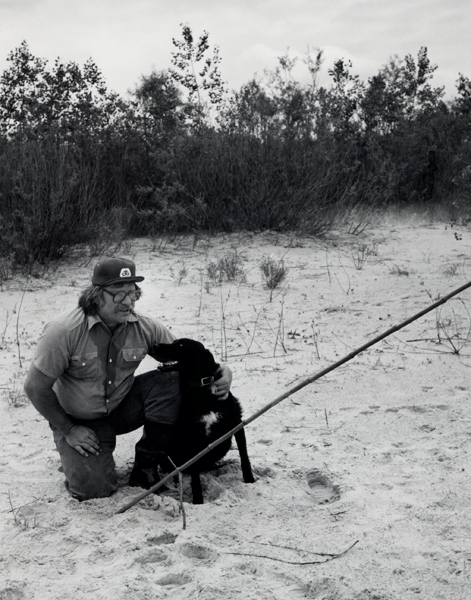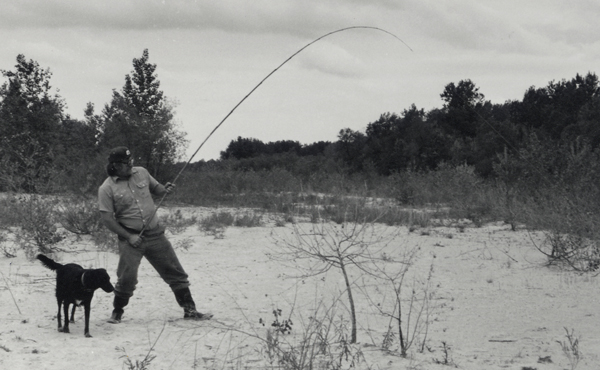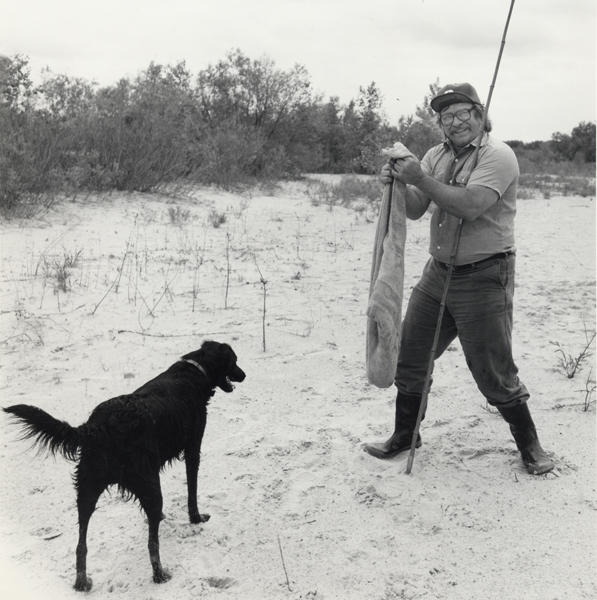The year 2022 has been a rough one–Nebraska has suffered the loss of some of its greatest storytellers. Early this year I blogged about the passing of Dick Turpin and Larry Porter. Now, unfortunately, the dean of Nebraska storytelling, Roger Welsch, passed a week ago.
I have no personal stories about Roger to share with you. Back in my college days at the University of Nebraska I tried several times to enroll in his folklore class. I never did because those classes were always full. Instead I have enjoyed his many writings over the years as have many Nebraskans and a lot of other folks from outside our borders. I have several of his books, and pull one out to re-read every now and then. I have been pleased that Roger has had several articles published in Nebraskaland Magazine over the years including one in the most recent issue, Privacy Schmivacy. Make sure you check out the online version and read it, page 50.
Years ago, during another dry spell, Nebraskaland published one of Roger’s adventures fishing for sandcats. With permission from the photographer and the magazine, I copied and pasted that story into my blog. The original story, Sandcat Safari, ran in the August 1984 edition of the magazine. In Roger’s honor, I would like to re-run that here in my blog again today:
Sandcat Safari
By Roger L. Welsch
Photos by Don Cunningham
NEBRASKAland – August 1984 – pg. 43
The white sandbar shimmered and glistened in the blinding August sun. There was not a cloud, even on the horizon. There wasn’t the slightest breeze. The temperature must have stood at 104 degrees but I was smiling because I knew that there is nothing a Nebraska Sandcat loves more than a day like this.
I approached a half-buried log quietly, from downwind, staying in the shade of bank shrubs, keeping low, avoiding letting my shadow fall across any likely resting places of my wary prey.
I flipped out a 32-pound-test line with a pickled turkey gizzard and pretzel bait combination. I couldn’t have dreamed of a better cast. I pulled the bait slowly, tantalizingly, across the sandbar, about 18 inches from the end of the partially buried cottonwood log.
Wham! A lunker almost tore the pole from my hands. I fretted momentarily about the light line I was using, but on the other hand I was grateful I had only this morning switched to a wire leader and cadmium-steel hooks. With some luck, just a little luck….
It was an angling moment of moments: I knew I had a prize-winner on the other end of that line—but my heart was filled with the agony of knowing, too, how fragile my hold on this Nebraska monster was. Only a thin, nylon thread was between me and the kind of personal and public recognition that comes from landing The Big One.
Not just A big one. THE Big One. The Nebraska Sand Catfish (Pisces feline-silicones) – one of the most elusive, slippery, and game catches of all.
For almost 20 years I had been seeking this ultimate prize in Nebraska angling. I had previously landed a dozen small ones, but I had also brought home a 17-pounder on one joyous occasion, so the passion was in me. I was hooked. The feel of those 17 pounds thrusting and lunging against my bamboo pole (the only form of rod sanctioned by the International Guidelines of Sandcats Unlimited) convinced me that I wanted to feel a 40, or 50, or 80-pounder on the end of a line, no matter how long it took me, no matter what the expense.
And, now, here I was, at last at the point of landing my Big One. I did manage to land the beast, but only after nearly six hours of struggle. It turned out to be a 67-pound giant—the Sandcat that won me my first Master Angler Award, a niche in the Sandcat Junior Hall of Fame in Ellsworth, and the envy of several dozen other frustrated members of the Nebraska Sandcat Anglers Club. (Better luck next time, fellows!)
That Sandcat was a prizewinner—but nowhere close to a Nebraska record (and it should be noted that all international records are held by Nebraska catches. Some biologists speculate that the Nebraska Sandcat is actually only a sub-species of the Mojave Sandcat, but anyone who has seen the two finds this thesis laughable. The Nebraska version is easily four times the size of the southwest American variety, and is distinguished by exceptionally thick skull bones.)
Let’s take a look at some Nebraska records:
-87 lbs. 3 ozs., taken near Lem’s Bluff four miles north of Thedford, April 1, 1927. Caught by Gloria Mundi on beef jerky.
-96 lbs. 17 ozs., landed near Mumpumpy Hill, Howard County, by Bruce Davis, April 1, 1981, on popcorn.
-16 lbs., 2 oz., and 12 lbs. even (only recorded double catch!), April 1, 1946, by Finias Ananias, on Jello (artificial bait and therefore not eligible for Sandcat Unlimited certification, unfortunately).
-23 lbs. even (only paddlebill Sandcat ever caught on baited hook), April 1, 1966, on blind robins by Duane Smith, in a freshly plowed field near McCool Junction.
I may not have any records to my name but I think most will agree that my 25 years of dedication have made me more knowledgeable about the Nebraska Sand Catfish than anyone else in the country. So, here are some of my ideas and hints about the most exciting angling Nebraska has to offer.
I prefer sandbar angling to upland angling. I know that about as many Sandcats are caught well up into the Sandhills as in dry rivers and washes, but I prefer to work he sandbars. It’s pretty much the same difference as that between river fishing and lake fishing. A matter of taste, I suppose.
I like a sandbar rather than a mud bar like those found on the Missouri or Elkhorn because the fish are going to taste cleaner (and as you will read further on, the eating is the best part of Sandcat fishing). I like a bar clean of brush and weeds but with a couple of half-buried logs where the big Sandcats are likely to be basking in the noonday sun.
I like to fish from the southwest side of a sandbar so my profile is concealed and so the fish have to look into the sun at me. It is a minor point, but I like to fish the white sands of the upper Platte and Loup River system, even though the dry backwashes of Salt Creek are considered the premier habitat—and the home of the Game Commission’s Sandcat Hatchery on the former site of Epworth Lake Park.
Until three years ago I considered trolling for Sandcats to be about as disgusting as catching rainbow trout on Velveeta cheese, but after Dick and Beth Whitefoot took me out Sandcat trolling on ATV’s southwest of Boelus, between the middle and south Loups, I changed my tune, but quick. It is a different sort of sport, but a challenging one.
The classic stance for the Sandcat fisherman is always that dictated by the International Sandcat Unlimited Handbook—
“…the casting of natural lures on a fiber (not metal) line, fixed to a reel-less bamboo pole, not more than 16 nor less than six feet long.”
There may be easier ways to catch the Sandcat but there certainly are no more sportsmanlike ways.
The International’s formula board is now considering the growing practice of fishing for Sandcat with ceramic lures tied to concrete blocks with clothesline wire, but the likelihood of the board approving that outlandish blasphemy is about as likely as Julia Child putting catsup on her grocery list.
I do feel that concrete, cast lead, and lumber lures are inappropriate for sport fishing, too, whatever the quarry, but the real dilemma, it seems to me, is whether wet lures should be acceptable.
Sandcats are normally drawn to dry foods in their natural diet—pinecones, cockleburs, and beernuts, for example—but occasionally the novelty of a watery food like cantaloupe or hailstones will attract them in the wild. Nonetheless I have my ethical doubts about the fairness of angling for them with watery baits such as cheap gas or Coors beer. Again, a look at the records will bear out my contention that the most honest bait—natural bait—is also the most effective bait.
Catching Sandcats at night is like looking for lightning bugs at noon. The hottest and brightest part of the day is the time to look for the brutes of the race, and you might just as well stay at home and read catalogs on the days it rains!
Perhaps the most important consideration in Sandcatting, and the one that makes the sport my favorite, is that it is an old man’s sport. The young man dashes about town, doing his best to see every eligible young lady available, all in one evening; but it is the old-timers who night after night exercise the patience in courting that wins the heart of the fairest of the fair.
So it is with the Sandcat. You sit and you wait. You look at the sky and read and drink a cool one and sit and wait. You stick with the old, reliable lures and avoid cute tricks, and you sit and you wait. And eventually, you land the Big One.
Of course the excitement of catching a Nebraska Sandcat is only the second of the Sandcat’s pleasures. The real joy is cooking one up and eating Sandcat tenderloin or barbecued ribs. My own favorite recipe has been handed down to me from my father, Chris Welsch, who holds the state record for the size and number of Sandcat caught on runzas—six cats for a total of 148 pounds, the biggest being 33 pounds, on November 6, 1936:
Skin the cat, removing all fins, barbs, tail, head, horns, and ticks. Slit belly from tail to head and remove all entrails except gizzard. Spread the fish belly-down on a 1 x 12” plank about two feet long. (I prefer cottonwood; Dad Welsch says Russian Olive is traditional). Tack the fish to the board with scaffolding nails. (Never, NEVER use epoxy glue in fish recipes). Brush bacon grease on the fish and board, season with sage, chili powder and Dorothy Lynch salad dressing. Prop the board and fish before a campfire for approximately 21 minutes, basting all the while with the seasonings suggested above. Finally, douse thoroughly with cheap bourbon, remove the fish from the board, discard the fish, and eat the board, with parsley or musk-thistle garnish.
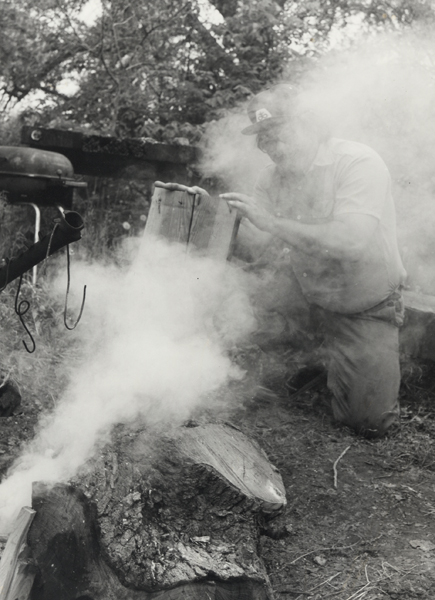
I have heard a lot of fishing stories in my time. I was told about the time it was so dry at Fremont that fish were coming up out of the Elkhorn to get a drink at the town pump. There were catfish in the Loup near Dannebrog wearing goggles to keep the dust out of their eyes. And, in the Platte, I have heard you can spot the fish by the little trails of dust they kick up as they move about the dry bed. But while others laugh, there are some of us who wink, get our potato chips and salt worms ready, make our expeditions out to Nebraska’s sandbars and Sandhills where crafty Sandcats lie waiting.
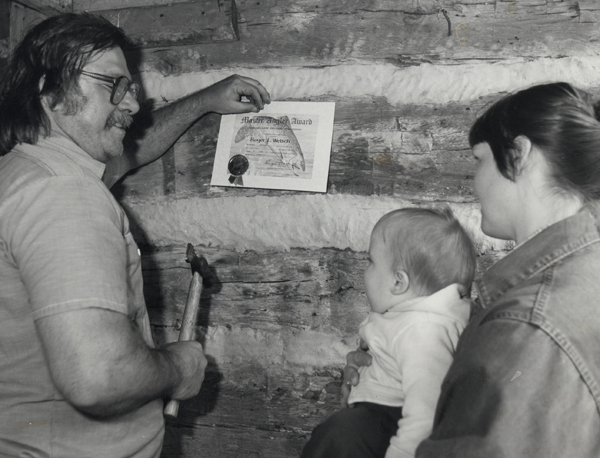
R.I.P. Roger, know you will find a good sandbar.
The post Roger the Storyteller appeared first on Nebraskaland Magazine.


